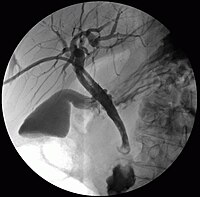
Photo from wikipedia
Percutaneous transhepatic biliary drainage (PTBD) has been an effective treatment to access the biliary tree, especially in case of endoscopically inaccessible biliary tree. In general, PTBD techniques are divided into… Click to show full abstract
Percutaneous transhepatic biliary drainage (PTBD) has been an effective treatment to access the biliary tree, especially in case of endoscopically inaccessible biliary tree. In general, PTBD techniques are divided into two methods: fluoroscopy-guided PTBD and ultrasound (US)-guided PTBD. This study aimed to evaluate the effectiveness of US-guided PTBD, focusing on radiation exposure according to intrahepatic duct (IHD) dilatation degree, differences between right- and left-sided approaches and differences between benign and malignant biliary stenosis/obstruction. We evaluated technical success, clinical success, procedural data (the number of liver capsule punctures, procedural time, fluoroscopy time and radiation dose), and procedure-related complications. During the study period, a total of 123 patients with biliary stenosis/obstruction or bile leakage were initially eligible. We excluded 76 patients treated with only ERCP or initially treated with ERCP followed underwent PTBD insertion. Finally, a total of 50 procedures were performed in 47 patients. Of the 47 patients, 8 patients had anatomical alteration due to previous surgery, 6 patients refused ERCP, and 3 patients failed ERCP. For the remaining 30 patients, PTBD was performed on weekend or at night, 11 of whom had poor general condition, 10 patients underwent ERCP 3 to 4 days later after PTBD insertion, 6 patients improved after PTBD insertion without ERCP, 1 patient died, and 1 patient was referred to other hospital. Remaining 1 patient underwent surgery due to Mirizzi syndrome. All procedures were performed by two interventional radiologists. Technical success rate was 100%, clinical success was 94%, and the complication rate was 10%. Fluoroscopy time and the reported radiation dose were significantly lower in patients with dilated bile ducts than in those with non-dilated bile ducts, when biliary puncture under US guidance was performed initially. However, even in patients with non-dilated bile ducts undergoing initial trials of biliary puncture under US guidance, the fluoroscopy time and the reported radiation dose were low, based on current studies. No statistical significant differences were observed in terms of technical and dosimetry results according to right-sided and left-sided procedures and benign and malignant biliary stenosis/obstruction. Thus, US-guided PTBD was found to be a safe and effective technique that significantly reduced fluoroscopy time and radiation doses.
Journal Title: PLOS ONE
Year Published: 2022
Link to full text (if available)
Share on Social Media: Sign Up to like & get
recommendations!